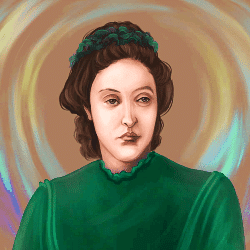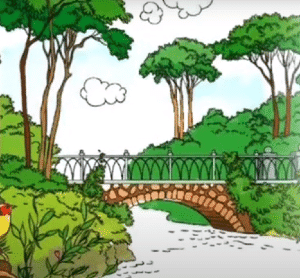Detailed Summary: Spring Quiet | English Reader New Gems Class 6 PDF Download
| Table of contents |

|
| About the Poet |

|
| Key Points of the Poem |

|
| Detailed Summary |

|
| Theme/ Message |

|
| Difficult Words |

|
About the Poet
Christina Rossetti was an English poet born in 1830 and passing away in 1894. She is one of the most famous female poets in English literature. Christina was educated at home by her mother, which allowed her to explore literature and poetry deeply. She was the sister of Dante Gabriel Rossetti, who was also a poet and painter. Christina wrote many types of poetry, but she is especially known for her devotional poems and children's poetry. Her work often reflects themes of love, nature, and spirituality.
Throughout her life, Christina faced many challenges, including health issues and the loss of loved ones. Despite this, her creativity flourished, and she became a significant figure in the Victorian literary world. Many of her poems express her thoughts on life, death, and the beauty of nature. She was influenced by her religious beliefs, which often appeared in her writings. Christina Rossetti's poetry continues to be appreciated for its emotional depth and lyrical beauty, making her a lasting presence in English literature.

Key Points of the Poem
- The poem consists of six quatrains, meaning it has six stanzas with four lines each.
- The main theme revolves around the beauty and tranquility of nature in springtime.
- It describes a peaceful place filled with birdsong and fresh scents, inviting the reader to imagine this serene setting.
- The speaker expresses a longing to escape to this natural haven, where one can feel safe and at peace.
- The poem contrasts the harshness of winter with the renewal of life that spring brings.
- There is a sense of safety and comfort in the natural world, free from the worries of life.
Detailed Summary
Stanza 1
Gone were but the Winter,
Come were but the Spring,
I would go to a covert
Where the birds sing.
In this stanza, the poet Christina Rossetti talks about the change of seasons. She says that winter is gone, and spring has arrived. Winter is often cold and gloomy, while spring is warm and full of life. The poet feels happy about spring because it brings fresh flowers, green leaves, and the cheerful songs of birds. She imagines going to a secret or hidden place, called a "covert," where she can listen to the beautiful singing of birds. This shows us that the poet loves nature and finds joy in the sounds of springtime. She is excited to leave behind the cold winter and embrace the warmth and happiness of spring.
Stanza 2
Where in the whitethorn
Singeth a thrush,
And a robin sings
In the holly-bush.
In this stanza, the poet describes the specific birds she hears singing in her secret place. She mentions a "whitethorn," which is a type of bush with white flowers. The thrush is a bird known for its sweet singing, and the robin is another bird that sings beautifully. The poet loves to hear these birds sing in the holly-bush, which is a bush with shiny green leaves and bright red berries. This part of the poem paints a lovely picture of spring and shows how nature is alive with sounds. By mentioning these birds, the poet makes us feel happy and connected to the beauty of the outdoors. It’s as if we can hear the birds singing along with her, making the scene feel more alive and joyful.
Stanza 3
Full of fresh scents
Are the budding boughs
Arching high over
A cool green house.
Here, the poet talks about the wonderful smells that come from the trees and plants, which are beginning to grow new leaves and flowers. The "budding boughs" means the branches of trees that are starting to bloom in spring. The poet describes these branches as "arching high," which means they stretch up towards the sky, making the place feel open and airy. She also mentions a "cool green house," which could be a place filled with plants or just a shady spot in nature. This part of the poem emphasizes how spring brings not only beauty but also delightful scents that make the air feel fresh and pleasant. When we read this, we can almost imagine walking into a lovely garden filled with the smell of flowers and the coolness of the shade. It makes us appreciate how wonderful nature can be in the springtime.
Stanza 4
Full of sweet scents,
And whispering air
Which sayeth softly:
“We spread no snare;
In this stanza, the poet continues to talk about the lovely scents and the gentle breeze in her secret place. The air is described as "whispering," which means it moves softly and quietly, almost like it is speaking to her. The whispering air seems to tell her that there are no traps or dangers around. "We spread no snare" means that this place is safe and peaceful, where she can relax and enjoy nature without worrying about anything bad happening. This creates a sense of comfort and security, showing that nature can be a wonderful escape from the busy or scary world outside. The poet wants us to feel that this special place is not only beautiful but also a safe haven, where she can be alone with her thoughts and feelings.
Stanza 5
Here dwell in safety,
Here dwell alone,
With a clear stream
And a mossy stone.
In this stanza, the poet invites us to imagine this beautiful place where she feels safe and at peace. She repeats "Here dwell," which makes us think that this is a special spot where she can be by herself. She describes a "clear stream," which is a small body of water that flows gently. Clear water is refreshing and makes the place feel lively. The poet also mentions a "mossy stone," which is a rock covered in soft, green moss. This adds to the natural beauty of the scene. This stanza gives us a feeling of calmness and tranquility, as if we could sit by the stream and enjoy the sights and sounds of nature. The poet wants us to understand that being in nature can make us feel safe, happy, and connected to the world around us.
Stanza 6
“Here the sun shineth most shadily;
Here is heard an echo
Of the far sea,
Though far off it be.
In the final stanza, the poet describes how the sun shines in this lovely place. She says it shines "most shadily," which means that while the sun is bright, its light is gentle and creates soft shadows. This gives a cozy feeling to the area. The poet also mentions that we can hear an "echo" of the faraway sea. An echo is when a sound bounces back to us after hitting something. Even though the sea is far away, the sounds of the waves can be heard softly in her peaceful spot. This connection to the sea reminds us of the beauty and vastness of nature. The poet paints a picture of a perfect, dreamy place where everything feels balanced and harmonious. The last lines leave us with a sense of wonder, making us feel that nature holds many secrets and joys just waiting to be discovered.
Theme/ Message
Theme
- Nature's Beauty: The poem highlights the beauty of nature, especially in spring. It describes the sights and sounds of a peaceful woodland area where birds sing and flowers bloom.
- Peacefulness: The poem conveys a sense of peace that comes from being in nature. It suggests that nature is a refuge where one can find solitude and comfort.
- Renewal: There is a strong theme of renewal and rebirth, as spring signifies the end of winter and the return of life. This symbolizes hope and new beginnings.
- Safety in Solitude: The poem suggests that being alone in nature can provide a sense of safety and contentment, away from the troubles of the world.
Message
- The poem encourages readers to appreciate the beauty and tranquility of the natural world. It reminds us that nature can be a source of joy and peace.
- It conveys the message that finding a quiet place in nature can help us escape our worries and find clarity in our thoughts.
- The imagery of birds singing and the fresh scents of spring serve to remind us of the joys of life and the importance of connecting with nature.
- By contrasting winter and spring, the poem emphasizes the idea that after difficult times, there is always the potential for renewal and joy.
Difficult Words
- Covert: A hidden or secluded place.
- Whitethorn: A type of bush or tree, also known as hawthorn, which has white flowers.
- Thrush: A type of bird known for its beautiful singing.
- Robin: A small bird with a red or orange breast, often associated with spring.
- Boughs: The main branches of a tree.
- Whispering: Speaking very softly; a gentle sound.
- Snare: A trap for capturing animals, used here metaphorically to suggest safety.
- Mossy: Covered with moss, a type of small green plant that grows in damp places.
- Shineth: An old-fashioned way of saying “shines.”
- Echo: A sound that is reflected off a surface and heard again.
- Far: A long distance away.
- Stream: A small, flowing body of water.
- Alone: Without other people; by oneself.
- Cool: Moderately cold, refreshing.
- Budding: Beginning to develop or grow, usually referring to new leaves or flowers.
|
69 videos|283 docs|61 tests
|




















